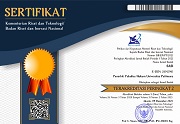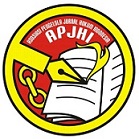SANKSI PIDANA TAMBAHAN BAGI PELAKU KEKERASAN SEKSUAL ANAK
 )
)
(1) , Indonesia
 Corresponding Author
Corresponding Author
Abstract
Violence especially sexual violence in children lately occurred in the midst of society. The media, both print and electronic almost daily, present news related to sexual violence, in which children are victims of perpetrators. On that occasion, there was a strong public reaction by condemning the actions of the perpetrators, they requested that the perpetrators be punished with the most severe punishment and some even ask the perpetrators to be punished by the law and sentenced to death. Given the cruel acts of the perpetrators not only arise the reaction of the community, but make the government, from the President, Social Minister, Minister of Justice and Human Rights and others, also members of the House voted to condemn the barbaric acts of the perpetrators and requested that perpetrators be punished weighing.
In response to this, the Government in this case President Joko Widodo on May 25, 2016 signed the Government Regulation in Lieu of Law (PERPPU) No. 1 of 2016 on the Second Amendment to Law No. 23 of 2002 on Child Protection. Which according to the term is generally called PERPPU Kebiri. The PERPPUalso regulates sanctions for heavier offenders also regulating additional criminal sanctions. Furthermore, on May 9, 2016 this PERPPU is set to become Law No. 17 of 2016. Given the importance and the need for security and free from threats to children, the protection of the victims is necessary so that he has a better future. Because it is related to the future of the nation, it is appropriate that additional punishment (the other and the other) for the perpetrator of child sexual violence. For the sake of justice, additional criminal sanctions of chemical curiosity, installation of electronic detection devices (chip), and announcement of the identity of perpetrators to the public for child sex offenders are considered effective, because it can: 1). Cause the deterrent effect for the perpetrator 2) .Press the action of sexual crime (especially in the short term), because the potential perpetrators are afraid and think again if they want to repeat the action again 3). Providing protection against victims (children) from sexual violence.
Keywords
DOI
10.47268/sasi.v23i1.158
Published
2017-06-30
How To Cite
@article{SASI158,
author = {Hb Sujiantoro},
title = {SANKSI PIDANA TAMBAHAN BAGI PELAKU KEKERASAN SEKSUAL ANAK},
journal = {SASI},
volume = {23},
number = {1},
year = {2017},
keywords = {Additional Criminal; Sexual Abuse; Child},
abstract = {Violence especially sexual violence in children lately occurred in the midst of society. The media, both print and electronic almost daily, present news related to sexual violence, in which children are victims of perpetrators. On that occasion, there was a strong public reaction by condemning the actions of the perpetrators, they requested that the perpetrators be punished with the most severe punishment and some even ask the perpetrators to be punished by the law and sentenced to death. Given the cruel acts of the perpetrators not only arise the reaction of the community, but make the government, from the President, Social Minister, Minister of Justice and Human Rights and others, also members of the House voted to condemn the barbaric acts of the perpetrators and requested that perpetrators be punished weighing.In response to this, the Government in this case President Joko Widodo on May 25, 2016 signed the Government Regulation in Lieu of Law (PERPPU) No. 1 of 2016 on the Second Amendment to Law No. 23 of 2002 on Child Protection. Which according to the term is generally called PERPPU Kebiri. The PERPPUalso regulates sanctions for heavier offenders also regulating additional criminal sanctions. Furthermore, on May 9, 2016 this PERPPU is set to become Law No. 17 of 2016. Given the importance and the need for security and free from threats to children, the protection of the victims is necessary so that he has a better future. Because it is related to the future of the nation, it is appropriate that additional punishment (the other and the other) for the perpetrator of child sexual violence. For the sake of justice, additional criminal sanctions of chemical curiosity, installation of electronic detection devices (chip), and announcement of the identity of perpetrators to the public for child sex offenders are considered effective, because it can: 1). Cause the deterrent effect for the perpetrator 2) .Press the action of sexual crime (especially in the short term), because the potential perpetrators are afraid and think again if they want to repeat the action again 3). Providing protection against victims (children) from sexual violence.},
issn = {2614-2961}, pages = {46--53} doi = {10.47268/sasi.v23i1.158},
url = {https://fhukum.unpatti.ac.id/jurnal/sasi/article/view/158}
}
Arief Gosila. 2004. Masalah-masalah Perlindungan Anak (Kumpulan Karangan), PT. Bhuana Ilmu Populer, Jakarta.
Barda Nawawi Arief.2007. Masalah-masalah Penegakan Hukum dalam Penanggulangan Kejahatan, Prenata Media Group, Jakarta.
Lilik Mulyadi. 2008. Bunga Rampai Hukum Pidana: Perspektif, Teoritis dan Praktik, Alumni, Bandung.
Mansour Fakih.1996. Analisis Gender dan Transformasi Sosial,Cetakan 1, Pustaka Pelajar, Yogyakarta.
Mardjono Reksodiputro.1994. Hak Asasi Manusia dan Sistem Peradilan Pidana, Pusat Pelayanan Keadilandan Pengabdian Hukum Lembaga Kriminologi Universitas Indonesia, Jakarta.
Muladi. 2000. Demokratisasi, Hak Asasi Manusia dan Reformasi Hukum di Indonesia,Cetakan Pertama, The Habibie Center, Jakarta.
Tim Penyusun Kamus Pusat Pembinaan dan Pengembangan Bahasa Departemen Pendidikan dan Kebudayaan.1988. Kamus Besar Bahasa Indonesia, Balai Pustaka, Jakarta
Undang-Undang Dasar Negara Rerpublik Indonesia Tahun 1945
Undang-undang Republik Indonesia Nomor 39 Tahun 1999 tentang Hak Asasi Manusia.
Undang-Undang Republik Indonesia Nomor .13 Tahun 2006 tentang Perlindungan Saksi dan Korban.
Undang-Undang Republik Indonesia Nomor 35 Tahun 2014 tentang Perubahan Atas Undang-Undang Nomore 23 Tahun 2002 tentang Perlindungan Anak.
Undang-Undang Republik Indonesia Nomor 17 Tahun 2016 tentang Penetapan Peraturan Pemerintah Pengganti Undang-Undang No 1 Tahun 2016 tentang Perubahan Kedua Atas Undang-Undang Nomor 23 Tahun 2002 tentang Perlindungan Anak Menjadi Undang-Undang.
| Dublin Core | PKP Metadata Items | Metadata for this Document | |
| 1. | Title | Title of document | SANKSI PIDANA TAMBAHAN BAGI PELAKU KEKERASAN SEKSUAL ANAK |
| 2. | Creator | Author's name, affiliation, country | Hb Sujiantoro; Indonesia |
| 3. | Subject | Discipline(s) | |
| 3. | Subject | Keyword(s) | Additional Criminal; Sexual Abuse; Child |
| 4. | Description | Abstract | Violence especially sexual violence in children lately occurred in the midst of society. The media, both print and electronic almost daily, present news related to sexual violence, in which children are victims of perpetrators. On that occasion, there was a strong public reaction by condemning the actions of the perpetrators, they requested that the perpetrators be punished with the most severe punishment and some even ask the perpetrators to be punished by the law and sentenced to death. Given the cruel acts of the perpetrators not only arise the reaction of the community, but make the government, from the President, Social Minister, Minister of Justice and Human Rights and others, also members of the House voted to condemn the barbaric acts of the perpetrators and requested that perpetrators be punished weighing.In response to this, the Government in this case President Joko Widodo on May 25, 2016 signed the Government Regulation in Lieu of Law (PERPPU) No. 1 of 2016 on the Second Amendment to Law No. 23 of 2002 on Child Protection. Which according to the term is generally called PERPPU Kebiri. The PERPPUalso regulates sanctions for heavier offenders also regulating additional criminal sanctions. Furthermore, on May 9, 2016 this PERPPU is set to become Law No. 17 of 2016. Given the importance and the need for security and free from threats to children, the protection of the victims is necessary so that he has a better future. Because it is related to the future of the nation, it is appropriate that additional punishment (the other and the other) for the perpetrator of child sexual violence. For the sake of justice, additional criminal sanctions of chemical curiosity, installation of electronic detection devices (chip), and announcement of the identity of perpetrators to the public for child sex offenders are considered effective, because it can: 1). Cause the deterrent effect for the perpetrator 2) .Press the action of sexual crime (especially in the short term), because the potential perpetrators are afraid and think again if they want to repeat the action again 3). Providing protection against victims (children) from sexual violence. |
| 5. | Publisher | Organizing agency, location | Faculty of Law, Universitas Pattimura |
| 6. | Contributor | Sponsor(s) | |
| 7. | Date | (YYYY-MM-DD) | 2017-06-30 |
| 8. | Type | Status & genre | Peer-reviewed Article |
| 8. | Type | Type | |
| 9. | Format | File format | PDF (Bahasa Indonesia) |
| 10. | Identifier | Uniform Resource Identifier | https://fhukum.unpatti.ac.id/jurnal/sasi/article/view/158 |
| 10. | Identifier | Digital Object Identifier | 10.47268/sasi.v23i1.158 |
| 11. | Source | Title; vol., no. (year) | SASI; Vol 23, No 1 (2017): Volume 23 Nomor 1, Januari - Juni 2017 |
| 12. | Language | English=en | id |
| 13. | Relation | Supp. Files | |
| 14. | Coverage | Geo-spatial location, chronological period, research sample (gender, age, etc.) | |
| 15. | Rights | Copyright and permissions | Copyright: Authors who publish their manuscripts in this Journal agree to the following conditions: 1. The copyright in each article belongs to the author, as well as the right to patent. 2. Authors can enter into separate, additional contractual arrangements for the non-exclusive distribution of the journal's published version of the work (e.g., post it to an institutional repository or publish it in a book), with an acknowledgment of its initial publication in this journal. 3. Authors are permitted and encouraged to post their work online (e.g., in institutional repositories or on their website) before and during the submission process, as it can lead to productive exchanges, as well as earlier and greater citation of published work. 4. Authors have the right to self-archiving of the article (Author Self-Archiving Policy)
License: The SASI Journal is disseminated based on the Creative Commons Attribution-NonCommercial 4.0 International license terms. This license allows anyone to copy and redistribute this material in any form or format, compose, modify, and make derivatives of this material for any purpose. You cannot use this material for commercial purposes. You must specify an appropriate name, include a link to the license, and certify that any changes have been made. You can do this in a way that is appropriate but does not imply that the licensor supports you or your use.
|
Copyright (c) 2019 Hb Sujiantoro

This work is licensed under a Creative Commons Attribution-NonCommercial 4.0 International License.

 : 3870 times
: 3870 times Download : 1212 times
Download : 1212 times
















